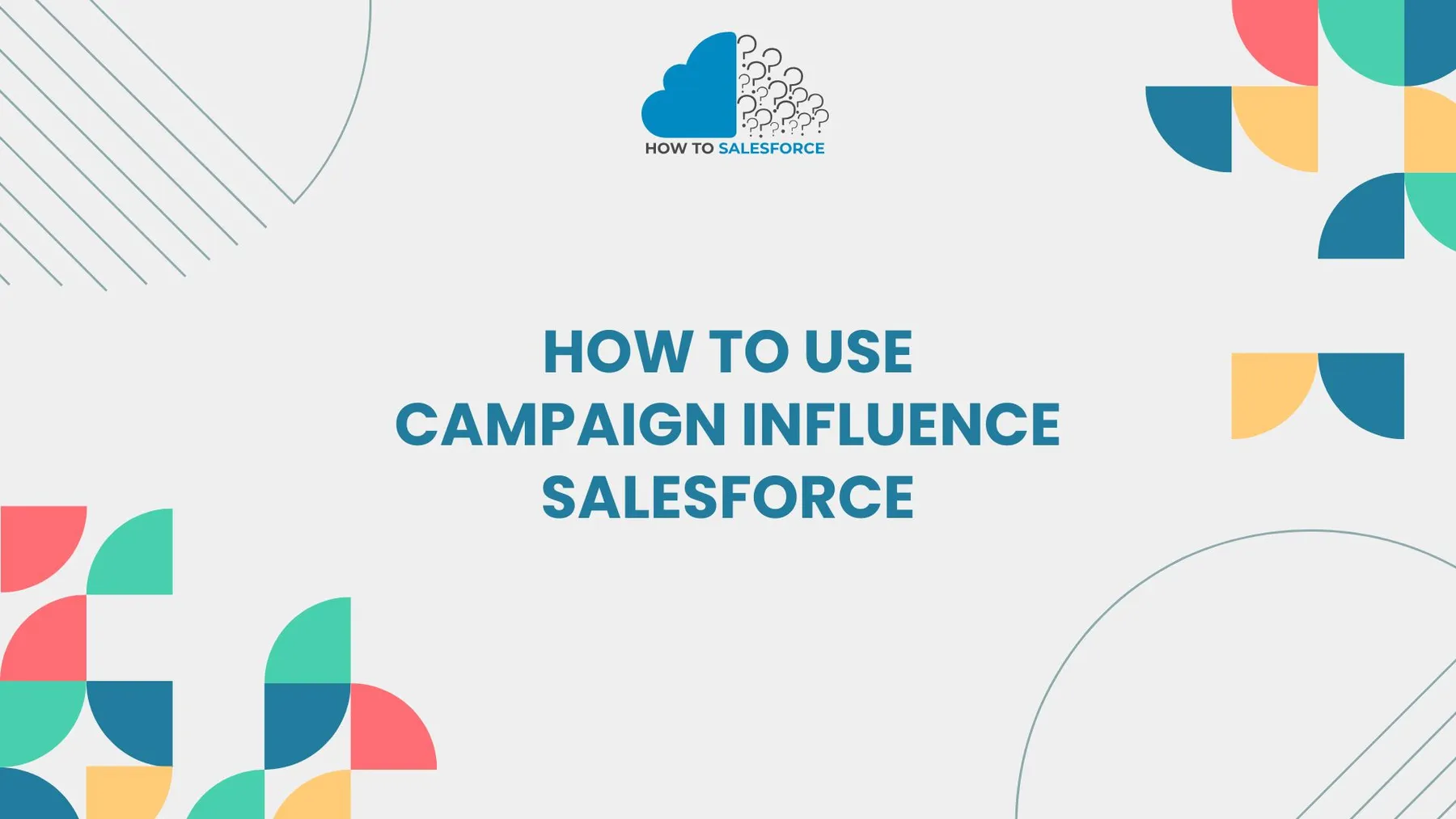In Salesforce, campaign influence is essential for monitoring and determining the effectiveness of your marketing initiatives. It provides insights that can enhance subsequent campaigns by assisting sales teams in identifying the marketing initiatives that resulted in closed deals. The technical know-how and leadership skills needed to maximize the feature will be covered in this blog post as we examine how to use campaign influence in Salesforce.
Please read my other blog: Can We Create Read-Only Fields in Screen Flow Salesforce
Introduction
Firstly, Both sales and marketing teams must be aware of the results of their work. Campaign influence in Salesforce allows you to assign revenue to particular campaigns. This useful tool makes it easier to monitor how various marketing campaigns affect sales. Teams can more efficiently distribute resources if they are aware of this.
What is Campaign Influence
Furthermore, Salesforce’s campaign influence feature enables companies to gauge how marketing campaigns affect prospects. It gives a clear picture of how marketing initiatives affect sales. This feature aids businesses in making well-informed decisions by enabling users to see which campaigns contributed to a particular opportunity.
- Multiple Campaigns Contribution: It allows for the assignment of multiple campaigns to a single opportunity.
- Customizable Models: The way influence is measured is up to the user.
- Revenue Attribution: It offers comprehensive reports on the effects of campaigns on sales revenue.
Key Components of Campaign Influence
In Salesforce, campaign influence is made up of several parts. Each is essential to efficiently tracking and managing your campaign data.
Influence Models
Salesforce provides several models for assigning campaign revenue. These models specify the allocation of influence to campaigns associated with a particular opportunity.
- First Touch Model: All revenue credit goes to the campaign that had the first interaction with the customer.
- Last Touch Model: All revenue credit goes to the campaign that closed the deal.
- Even Distribution Model: All campaigns that contributed to the opportunity receive an equal share of the revenue.
Campaign Influence Records
Records of campaign influence demonstrate how each campaign helped create the opportunity. When an opportunity is linked to a campaign, these records are automatically generated.
- Opportunity Campaign Influence: Indicates the percentage of influence each campaign had on the deal and links campaigns to opportunities.
- Manual Influence Records: To reflect more precise data, influence percentages can be manually adjusted.
Influence Attribution
Moreover, How much credit a campaign should get for a deal is determined by attribution. Salesforce enables users to personalize attribution models, guaranteeing precise campaign impact tracking.
- Auto-Association: Salesforce uses predetermined criteria to automatically link campaigns to opportunities.
- Custom Attribution Models: To meet your unique business requirements, you can design custom models.
How to Set Up Campaign Influence in Salesforce
Let’s get started with setting up campaign influence in Salesforce now that you know its components. Accurate campaign performance tracking and reporting depend on proper setup.
Step 1: Enable Campaign Influence
You must first enable campaign influence in your Salesforce environment before you can begin using it.
- Setup Navigation: Select Setup > Campaign Influence Settings.
- Enable Campaign Influence: To make the feature available, check the box.
Step 2: Customize Campaign Influence Models
Users can personalize their campaign influence models with Salesforce. Businesses can better match the feature to their unique requirements thanks to this customization.
- Setup Navigation: Select Setup > Campaign Influence Models.
- Create a New Model: To create a personalized model, click New Model.
- Define Criteria: Establish the model’s parameters, such as the attribution percentage.
Step 3: Add Campaigns to Opportunities
You can begin linking campaigns to opportunities as soon as campaign influence is enabled.
- Navigate to Opportunity Records: Select the opportunity that you want to link to a campaign.
- Add Campaign Influence Record: In the Campaign Influence related list, scroll down and select Add Campaign.
- Select Campaign: From the list, pick the appropriate campaign and save.
Best Practices for Using Campaign Influence
Furthermore, using best practices can increase the effectiveness of campaign influence. The following advice will help you get the most out of this Salesforce feature.
Use Multiple Influence Models
You might not get a true picture of your marketing efforts if you only use one model. You can obtain a thorough understanding of the effectiveness of your campaigns by utilizing a variety of models.
- First-Touch and Last-Touch Models: Combining these models yields a complete picture of the client journey.
- Custom Models: For improved insights, develop models that meet your unique business needs.
Regularly Review and Adjust Influence Records
Regularly reviewing and adjusting your campaign influence records is crucial for maintaining accurate data.
- Check Influence Percentages: Verify that the appropriate campaigns are receiving the appropriate credit for their level of influence.
- Manual Adjustments: For accurate reporting, don’t be afraid to make manual record adjustments when needed.
Align Marketing and Sales Teams
The sales and marketing teams need to collaborate in order to accurately measure the impact of campaigns. These teams can better align their efforts and enhance revenue attribution by communicating on a regular basis.
- Cross-Functional Meetings: Review campaign influence data from sales and marketing at regular meetings.
- Common Objectives: Ascertain that the two teams have similar objectives for campaign performance and revenue attribution.
How to Analyze Campaign Influence Data
Following the establishment of campaign influence, data analysis will help make informed decisions. Salesforce provides a number of methods for reviewing and comprehending the revenue impact of your campaigns.
Campaign Influence Reports
You can create comprehensive reports on campaign influence using Salesforce. The contribution of campaigns to closed deals is clearly visible in these reports.
- Navigate to Reports: by selecting the Reports tab and then selecting “New Report.”
- Choose Campaign Influence Report Type: To begin, choose the type of Campaign Influence report.
- Customize Fields: Add fields for better insights, such as Opportunity Amount, Campaign Name, and Influence Percentage.
Dashboards
Salesforce dashboards provide for the visual tracking of campaign influence. It is possible to create dashboards that show key performance indicators (KPIs) connected to campaign influence.
- To create a new dashboard: go to Dashboards and select “New Dashboard.”
- Include Components: To visualize your campaign influence data, use elements such as bar graphs and pie charts.
- Set Filters: Use filters to highlight particular opportunities, campaigns, or time frames.
Key Metrics to Track
Pay close attention to the following crucial metrics when examining campaign influence data:
- Influence Percentage: This figure indicates the amount of credit given to each campaign.
- Revenue Attribution: Monitor the amount of money that each campaign is responsible for.
- Campaign ROI: Determine each campaign’s return on investment (ROI) by calculating how many deals it has influenced.
Challenges and How to Overcome Them
Effective campaign influence utilization necessitates overcoming a few typical obstacles. The most common problems and solutions are listed below.
Duplicate Campaign Records
Data duplication can occasionally occur when several campaigns are linked to the same opportunity.
- Solution: Audit your campaign influence records regularly to get rid of duplicates. Make use of Salesforce’s integrated data cleaning tools.
Inconsistent Attribution Models
Tracking the effectiveness of campaigns can be challenging due to erroneous data produced by inconsistent attribution models.
- Solution: Standardize your attribution models for all campaigns. Ensure that every person in your organization understands and uses each model.
Lack of Cross-Departmental Collaboration
Marketing and sales data are essential for campaign influence. The data might not be reliable if these teams don’t work together.
- Solution: Promote cooperation between marketing and sales by holding frequent meetings and using common KPIs.
Conclusion
To sum up, Salesforce’s campaign influence feature effectively monitors and credits marketing-related revenue. Businesses can obtain important insights into which campaigns generate sales by properly configuring and utilizing this feature. Accurate and useful results can be ensured by aligning the marketing and sales teams, adhering to best practices, and routinely analyzing data. To enhance your marketing tactics and increase sales, utilize campaign influence immediately.
Effective campaign influence deployment gives teams the ability to make data-driven decisions, which improves overall company performance.


